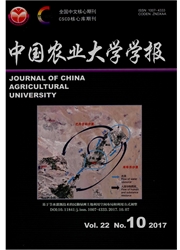

 中文摘要:
中文摘要:
通过构建农作物秸秆沼气化利用潜力估算模型和秸秆沼气燃烧的碳足迹模型,对1995—2014年中国主要农作物秸秆资源量、秸秆沼气化潜力及其温室气体减排潜力进行计算,并分析了标准煤燃烧、秸秆直接燃烧及秸秆沼气燃烧的碳足迹,揭示了秸秆沼气化的减排效果。研究结果表明:1)1995—2014年秸秆资源量(含田间秸秆和加工副产物)年均值为7.55亿t。2)秸秆沼气化潜力巨大,若将其中37.5%的农作物秸秆沼气化,平均每年可产1 188.9亿m^3沼气,可替代约0.85亿t的标准煤。3)与秸秆直接燃烧碳足迹相比,秸秆沼气燃烧碳减排效果明显,1995—2014年秸秆沼气燃烧的碳足迹年均减少2.08亿t(CO2eq),较秸秆直接燃烧减排46.8%。秸秆沼气化利用能够明显减少温室气体排放量,发展潜力巨大。
 英文摘要:
英文摘要:
Research on the carbon footprint of crop residue biogas utilization is very important to clean energy utilization of the crop residue. This study constructed crop residue biogas potential estimation model and carbon footprint calculation model, and the carbon footprint of the direct burning process of the stand coal, the crop residue and the crop residue biogas were then compared in order to discover the effect of greenhouse gas emissions reduction. The results showed that the annual average crop residue resource reached 7.55 x 108 t during 1995 - 2014. If 37.5% of the crop residue were used for biogas generation, 1 188.9 x 108 m3 bJogas wouJd be produced, which substituted for 0.85 x 108 t stand coal. Compared with crop residue direct burning, the annual average carbon footprint of crop residue biogas during 1995- 2014 reduced by 2.08 x 108 t CO2 equivalent which accounted for 46.8% of the carbon footprint of crop residue direct burning. Crop residue biogas utilization can significantly reduce greenhouse gas emissions and is a promising development for clean energy utilization in China.
 同期刊论文项目
同期刊论文项目
 同项目期刊论文
同项目期刊论文
 期刊信息
期刊信息
